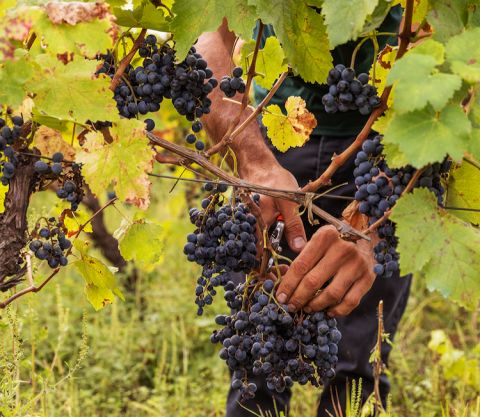From $19.99, £17.60
Find the Unfiltered Saperavi; see below for where to find the Saperavi Selection in the US.
Make sure you look out for Teliani Valley’s Winery 97 Unfiltered Saperavi (in the UK) and Saperavi Selection (in the US) because Teliani Valley make several other Saperavis, including a slightly less expensive one in the Winery 97 series (filtered and from a different part of the vineyard) and a much less expensive one in a completely different livery. (Ignore the vintages in the bottle shots below. They do also sometimes use the name Teliani Vineyards rather than Teliani Valley because, apparently, they were advised that ‘that word “Valley” does not express exactly the place for US consumers, so created labels “Teliani Vineyards”’. Who’d be a marketer?)
With discussions in the air about what to drink at special celebrations (see Thanksgiving wine strategies and Festive questions answered), and with readers of this site in both hemispheres, I thought this unoaked red, with 13% alcohol, would be a versatile, food-friendly wine of the week that could be enjoyed whatever the weather or occasion, even if the occasion is nothing more than Tuesday night. (I remember once asking German winemaker Klaus Peter Keller when he would drink a particular wine and he disarmingly replied, ‘On a Tuesday night.’)
Georgia’s most widely planted dark-skinned grape variety Saperavi produces deeply coloured wines – Saperavi means ‘dye’ in Georgian – and it can be quite a tannic variety but Teliani Valley’s chief winemaker Mikheil Khmelidze (below) and his team have managed to produce a wine that is fragrant and open, with tannins that are finely textured and dry but not in the least drying.
In my tasting note I described it as a bit of a conundrum: ‘while it is not an overtly fruity wine, it is all about the fruit and the brilliantly managed tannins. Dry, pure, elegant and long. Proves that a red wine does not need any oak influence to be a fine wine.’
It’s ready to drink but it should also age well over at least the next five years.
Teliani Valley is a relatively big producer in Kakheti, Georgia’s most important wine-growing region in the south-west of the country (as shown on this World Atlas of Wine map) that is the source of about 80% of the country’s wine. (Teliani is also an appellation within Kakheti, as the map shows.)
The company’s overall annual production is c 3.5 million bottles but several years ago they created a ‘special series’ of wines to celebrate the creation of the company in 1997, hence Winery 97. Confusingly these words appear only on the back label but the bottle shape and label are different from those used for their other ranges. Under the Winery 97 brand name they produce nearly 300,000 bottles, including this particular Saperavi.
The grapes come from a 7-ha (17-acre) 20-year-old vineyard in the village of Ikalto, east of Telavi, planted on gravelly clay soil and owned by Teliani Valley, as are all the vineyards which supply the fruit for the Winery 97 series. (For some of their less expensive wines, they buy fruit from local farmers.)
I asked Khmelidze how he managed to make an unoaked Saperavi with such refined tannins since oak is often used to soften the tannins of dark-skinned grapes that are known to be tannic – not just Saperavi of course but also others such as Cabernet Sauvignon.
Khmelidze told me that, firstly, when the alcoholic fermentation in stainless-steel tanks is complete, after about 10 days, the wine is pressed off the skins so there is no post-fermentation maceration and no more tannins can be extracted from the skins. Secondly, they do not include any whole bunches in the fermenting vat, a common practice with Saperavi, especially when fermented in clay qvevri, and one which adds more tannins from the stems. They prefer not to filter this bottling ‘to show fully the amazing colour of Saperavi and more wild and fresh character’. It has heaps of both.
They also pointed out that the use of oak for Saperavi was never a Georgian tradition, even if it has become more common today. Bearing in mind that wine has been made in Georgia for 8,000 years, oak is a relative newcomer. ‘For sure oak helps us to soften tannins, but oak never was something that we used to make our job easier’, wrote Khmelidze.
Hats off therefore to Khmelidze and his team for shepherding these grapes through the winery to produce such a pure, delicious and harmonious Saperavi that puts the variety’s dark-fruit as well as more savoury flavours to the fore. It may not have involved costly oak barrels but it is worth every penny.
The Unfiltered Saperavi is imported into the UK by Boutinot Wines, who tell me it is available from D’Arcy Wines (who currently have the best UK price), Drinkmonger, Latitude Wine, Tetbury Wines and Theatre of Wine. In the US, Saperavi Selection is imported by Georgian Wine House, JVS Imports and Serendipity Wines, and available online nationally from Plum Market. For other distributors worldwide, see Teliani’s Where to buy page. (Incidentally, the 2019 vintage, which is still available from some retailers, is also very good.)
While researching this wine, I discovered an interesting initiative by Teliani Valley: Wine People. It’s a talent incubation project that, according to Madeleine Waters of Swirl Wine Group (which works with Teliani Valley in the UK), ‘nurtures micro-growers and winemakers and gives them a platform and the facilities to make their own wine, with a view to launching them on their way to create their own brands … Many of these producers have gone on to attract investment and set up their own wineries.’ Look out for that label if you want to encourage new, young Georgian winemakers.
For more reviews of many styles of Saperavi from Georgia and elsewhere – unoaked, oaked, made in clay qvevri or stainless steel – see our tasting notes database. Come back for more in my article on a selection of Georgian wines next week. All photos courtesy of Teliani Valley.


















